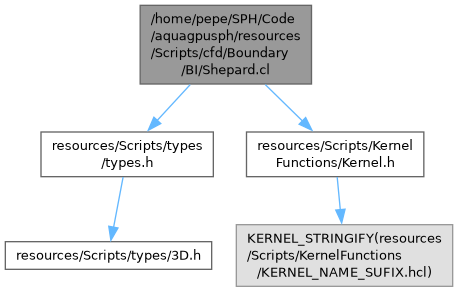Boundary integral term computation. (See Aqua::CalcServer::Boundary::DeLeffe for details) More...
Include dependency graph for Shepard.cl:

Macros | |
| #define | _SHEPARD_ shepard[i] |
Functions | |
| __kernel void | compute (const __global int *imove, const __global vec *r, const __global vec *normal, const __global vec *tangent, const __global vec *binormal, const __global float *m, __global float *shepard, const __global uint *icell, const __global uint *ihoc, uint N, uivec4 n_cells) |
| Shepard factor computation. | |
| __kernel void | apply (const __global int *imove, const __global float *shepard, __global vec *grad_p, __global vec *lap_u, __global float *div_u, uint N, float cs) |
| Renormalize the differential operators. | |
Detailed Description
Boundary integral term computation. (See Aqua::CalcServer::Boundary::DeLeffe for details)
Macro Definition Documentation
◆ _SHEPARD_
| #define _SHEPARD_ shepard[i] |
Function Documentation
◆ apply()
| __kernel void apply | ( | const __global int * | imove, |
| const __global float * | shepard, | ||
| __global vec * | grad_p, | ||
| __global vec * | lap_u, | ||
| __global float * | div_u, | ||
| uint | N, | ||
| float | cs | ||
| ) |
Renormalize the differential operators.
The main drawback of the boundary integrals formulation is the requirement of the renormalization of the computed differentiqal operators, which is destroying several conservation properties.
- Parameters
-
imove Moving flags. - imove > 0 for regular fluid particles.
- imove = 0 for sensors.
- imove < 0 for boundary elements/particles.
shepard Shepard term \( \gamma(\mathbf{x}) = \int_{\Omega} W(\mathbf{y} - \mathbf{x}) \mathrm{d}\mathbf{x} \). grad_p Pressure gradient \( \frac{\nabla p}{rho} \). lap_u Velocity laplacian \( \frac{\Delta \mathbf{u}}{rho} \). div_u Velocity divergence \( \rho \nabla \cdot \mathbf{u} \). N Total number of particles and boundary elements. cs Speed of sound \( c_s \).
- See also
- Boundary/BI/Interactions.cl
Here is the call graph for this function:

◆ compute()
| __kernel void compute | ( | const __global int * | imove, |
| const __global vec * | r, | ||
| const __global vec * | normal, | ||
| const __global vec * | tangent, | ||
| const __global vec * | binormal, | ||
| const __global float * | m, | ||
| __global float * | shepard, | ||
| const __global uint * | icell, | ||
| const __global uint * | ihoc, | ||
| uint | N, | ||
| uivec4 | n_cells | ||
| ) |
Shepard factor computation.
\[ \gamma(\mathbf{x}) = \int_{\Omega} W(\mathbf{y} - \mathbf{x}) \mathrm{d}\mathbf{y} \]
The shepard renormalization factor is applied for several purposes:
- To interpolate values
- To recover the consistency with the Boundary Integrals formulation
- Debugging
In the shepard factor computation the fluid extension particles are not taken into account.
- Parameters
-
imove Moving flags. - imove > 0 for regular fluid particles.
- imove = 0 for sensors.
- imove < 0 for boundary elements/particles.
r Position \( \mathbf{r} \). normal Normal \( \mathbf{n} \). tangent Tangent \( \mathbf{t} \). binormal Binormal \( \mathbf{b} \). m Area of the boundary element \( s \). shepard Shepard term \( \gamma(\mathbf{x}) = \int_{\Omega} W(\mathbf{y} - \mathbf{x}) \mathrm{d}\mathbf{y} \). icell Cell where each particle is located. ihoc Head of chain for each cell (first particle found). N Number of particles. n_cells Number of cells in each direction
Here is the call graph for this function:
